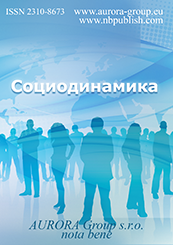Humanitarian projects
Reference:
Kudashov, V.I., Mosienko, M.K. (2015). ADDICTION DEVELOPMENT IN COMMON MIND. Sociodynamics, 2, 1–14. https://doi.org/10.7256/2409-7144.2015.2.14517
Abstract:
Authors analyze “drug” as a philosophical notion and describe the ontological basis for addiction development in common mind. The relevance of such an analysis is clear from the fact that external factors traditionally associated with addiction only create favorable conditions for its development, but do not cause it directly. This article describes the basic (though not always immediate) reason for addiction development in common mind as well as its forms and adjacent coping stratagies.
Keywords:
neurosis, suffering, religious studies, social sciences, coping stratagies, drug, narcotization, common mind, pain, religion
Humanitarian projects
Reference:
Ma, L. (2015). On the issue about the features of social advertising communications in contemporary Chinese society. Sociodynamics, 2, 15–36. https://doi.org/10.7256/2409-7144.2015.2.14458
Abstract:
Subject of research - the specificity of social communications in modern Chinese advertising. Chinese advertising displays basic cultural values, which are encoded in the Chinese national picture of the world. The form and content of Chinese advertising texts are a combination of two opposite aspects: the global mass culture with its cliches and stereotypes, on the one hand, and the Chinese traditional culture with its characters, symbols, images, reproducing in this culture for thousands of years. Research on the effectiveness of Chinese advertising show that its effectiveness is related to the appeal to the basic ideals, norms and traditions.The main method of research - a review of scientific publications on the subject of representation of basic cultural values in advertising in contemporary China. Reviewed and analyzed the most cited publications on the reflection of Chinese standards and ideals in advertising signs, images, symbols. We agree with those scientists who believe that the Chinese regional culture quite successfully opposed a profound impact on her stamps global mass culture.Modern social studies Chinese advertising show that the political managers of modern China have learned to use advertising images, texts for the construction of national values. However, there is temporal dynamics, revealing the effectiveness of westernized advertising images when they are turned to the younger generation of modern China, living in the city and having a high income. The mass consumer market of China upbeat advertisements, which encoded the fundamental social and cultural values, uses traditional artistic images.
Keywords:
China, representation, the advertising text, cultural identity, cultural studies, social values, social communication, social studies, traditional culture, globalization
Humanitarian projects
Reference:
Obmorokova, A.M. (2015). Formation of regional identity and the method of implementing the concept of . Sociodynamics, 2, 37–53. https://doi.org/10.7256/2409-7144.2015.2.14394
Abstract:
The subject of the research are specific mechanisms and technologies of such a variety of social identity as a regional identity (in the context of the concept of "new regionalism"). Mechanisms of formation of regional identity allow you to specify the most effective social and cultural practices that contribute to activation of the population for the development of a specific territory. Modern problems of the mechanisms of formation of regional identity and self-identity is revealed in the aspect of "soft" power, cultural policy, creative activities actors living and working in a particular region. The article deals with the processes in the Krasnoyarsk regional culture associated with the ways in which the artists embody the meaning of the concept "homeland". The main method of research - analytical and critical review of existing scientific literature on the subject of the study. Also used comparative-historical method and comparative genetic method. The definition of the concept of "Homeland" in the artistic culture of our region and its changes over time, is an important aspect in the study of consciousness of people living in Siberia and their ability to form their own regional identity. To date, art and culture, through the understanding of the uniqueness and diversity of creativity of local artists may help resolve the problem of national identity, which is at a low level.
Keywords:
Krasnoyarsk region, Siberia, homeland, self-identity, identity, region, culture, regional studies, concept, artistic Culture
Humanitarian projects
Reference:
Nemaeva, N.O. (2015). Formation of the Russian social and cultural identity by means of rebirth of sacred art. Sociodynamics, 2, 54–67. https://doi.org/10.7256/2409-7144.2015.2.14404
Abstract:
This article investigates the place icons in the modern social and cultural space, the basic problems of modern religious art (icons), ways and tendencies of its development, the place of icons in popular culture, the perception of the icons individual and society, the transformation of the iconography in the context of socio-cultural dynamics, the role of contemporary religious art in the formation of Russia's cultural identity. This topic is highly relevant to the extensive background of globalization and the universalization of traditional bias towards the axiological values promoted by mass culture. The basic method - analytical and critical review of the scientific literature on the subject of research, including foreign and domestic works published over the past 10 years. Made a brief overview and critical analysis of the articles of modern researchers in the field of research. The conclusions that the sacred art contributes to the formation of cultural and ethnic identities, and such positive qualities as national patriotism, collegiality, stamina, desire for absolute values that are important (moral goodness, beauty, knowledge of the truth).
Keywords:
Siberia, sacred art, orthodoxy, social identity, Russian identity, cultural studies, social studies, Icon Painting, traditions, innovation
The heritage of transformation
Reference:
Kazakevich, O. (2015). «Sexual citizenship»: conceptualizing the notion. Sociodynamics, 2, 68–85. https://doi.org/10.7256/2409-7144.2015.2.14506
Abstract:
The concept of sexual citizenship which has become widely used in the western academia is explored in this paper. In particular, the special attention is given to the history of the concept and the ways of establishing and accepting new identities. The hot issues of the western debates are of our particular concern: the first one is the concept of the body within the citizenship framework; the second one is the division between private and public; finally, the transformation of intimacy. We offer to define the concept of sexual citizenship as a complex category which describes new politics and practices of citizenship in relation to sexuality and allows (at least, potentially) new subjectivities to become incorporated into the public sphere on the different levels: from the freedom of speech to the freedom of identity.
Keywords:
heteronormativity, sexuality, feminism, subjectivity, identity, gender, sexual citizenship, citizenship, homosexuality, intimacy
 This work is licensed under a Creative Commons Attribution-NonCommercial 4.0 International License.
This work is licensed under a Creative Commons Attribution-NonCommercial 4.0 International License.
 Eng
Eng











 © 1998 – 2025 Nota Bene. Publishing Technologies. NB-Media Ltd.
© 1998 – 2025 Nota Bene. Publishing Technologies. NB-Media Ltd.




